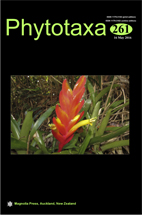Abstract
A new species, Zingiber ventricosum, endemic to Yunnan Province of southwestern China, is described and illustrated. It is similar to Z. oligophyllum, Z. thorelii and Z. xishuangbannaense in having much-reduced ligules, usually elongated petioles, flower shape and glabrous ovaries. Zingiber ventricosum, however, is readily distinguished from its three relatives by having erect peduncles and convex bracts that are inflated at their bases and acuminate and wide-spreading at their apices. These four species belong to Zingiber sect. Cryptanthium and together compose the informal “Z. oligophyllum complex”. This complex has a rather wide geographic distribution that extends from southern China to Thailand, Laos and southern Vietnam and to Taiwan, China. The three previously described species are revised based on a study of herbarium specimens, as well as living plants. Zingiber xishuangbannaense, previously regarded as conspecific with Z. thorelii, is resurrected here. Some of the previous records of Z. thorelii from Thailand are assigned to Z. xishuangbannaense, while the remaining records represent an as-yet unidentified taxon. Zingiber oligophyllum, previously reported as endemic to Taiwan, is now recorded for southeastern mainland China and Hong Kong. Descriptions, colour plates, distribution maps and preliminary IUCN conservations assessments for the four species are provided, together with a key to these species. Lectotypes for Z. oligophyllum and Z. xishuangbannaense are designated here, and the previous lectotypification of Z. thorelii is narrowed to a single specimen. Based on the latest IUCN criteria, Z. ventricosum is proposed to be Critically Endangered (CR), while the other three species qualify as least concern (LC).

